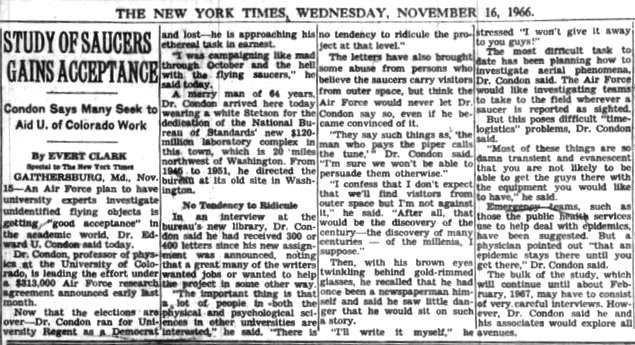This article was published in the daily newspaper The New York Times, New York City, USA, on November 16, 1966.

|
By EVERETT CLARK
Special to The New York Times
GAITHERSBURG, MD., Nov 15. -- An Air Force plan to have university experts investigate unidentified flying objects is getting "good acceptance" in the academic world, Dr. Condon said today.
Dr. Condon, professor of physics at the University of Colorado, is leading the effort under a $313,000 Air Force research agreement announced early last month.
Now that the elections are over - Dr. Condon ran for University Regent as a Democrat and lost - he is approaching is etheral task in earnest.
"I was campaigning like mad though October and the hell with the flying saucers," he said today.
A merry man of 64 years, Dr. Condon arrived here today wearing a white Stetson for the dedication of the National Bureau of Standards' new $120 million laboratory complex in this town, which is 20 miles northwest of Washington. From 1945 to 1951, he directed the bureau at its old site in Washington.
In an interview at the bureau's new library, Dr. Condon said he had received 300 or 400 letters since his new assignment was announced, noting that a great many of writers wanted jobs or wanted to help the project in some other way.
"The important thing is that a lot of people in both the physical and the psychological sciences in other universities are interested," he said. "There is no tendency to ridicule the project at that level."
The letters have also brought some abuse from persons who believe the saucers carry visitors from outer space, but think the Air Force would never let Dr. Condon say so, even if he became convinced of it.
"They say such thing as, 'the man who pays the piper calls the tune,'" Dr. Condon said. "I'm sure we won't be able to persuade them otherwise."
"I confess that I don't expect that we'll find visitors from outer space but I'm not against it," he said. "After all, that would be the discovery of the century - the discovery of many centuries - of the millennia, I suppose."
Then, with his brown eyes twinkling behind gold-rimmed glasses, he recalled that he had once been a newspaperman himself and said he saw little danger that he would sit on such a story.
"I'll write it myself," he stressed "I won't give it away to you guys!"
The most difficult task to date has been planning how to investigate aerial phenomena. Dr. Condon said the Air Force would like investigating teams to take the field wherever a saucer is reported as sighted.
But this poses difficult "time-logistic" problems, Dr. Condon said.
"Most of these things are so damn transient and evanescent that you are not likely to be able to get the guys there with the equipment you would like to have," he said.
Emergency teams, such as those of the public health services use to help deal with epidemics have been suggested. But a physician pointed out "that an epidemic stays there until you get there," Dr. Condon said.
The bulk of the study, which will continue until about February, 1967, may have to consist of very careful interviews. However, Dr. Condon said he and his associates would explore all avenues.
What the US Air Force had asked was that the university's research project carries out field investigations, by using teams of other universities, hence these letters proposing help and contributions.
What Dr. Condon does here, after having shown that it had sent the saucers to hell because his election campaign was more important, is to reject the idea of field investigation with the weasel argument that the field investigations are impossible because when the investigators arrive, the saucer is already gone.
To learn what Dr. Condon's project was really about to do, see here.